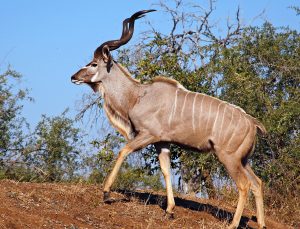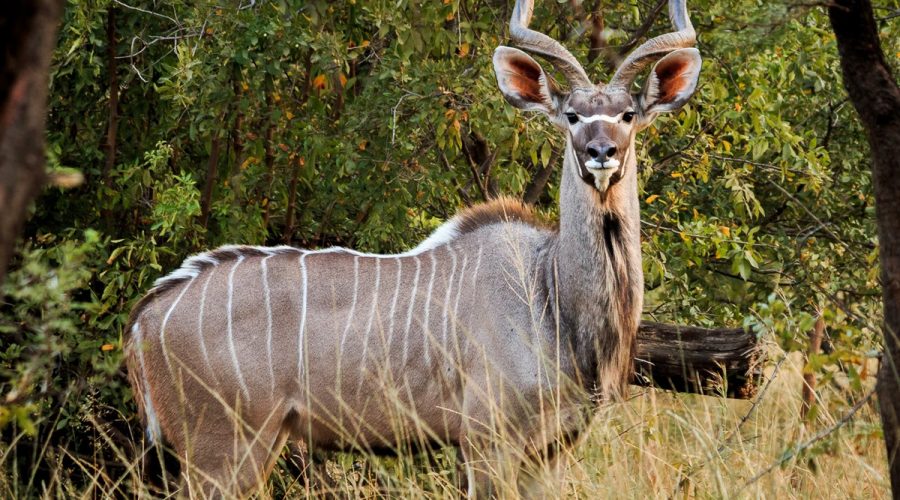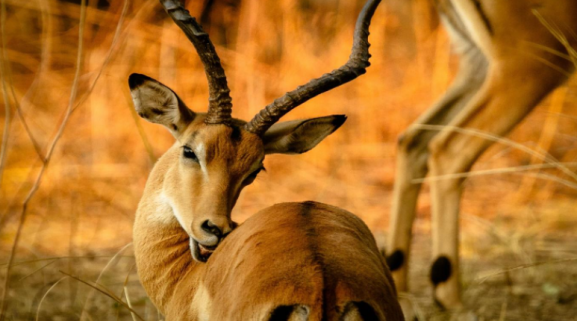Biltong Hunting South Africa: The Kudu
Biltong Hunting South Africa: The Kudu
Kudu has been said to be the best tasting game meat, luckily for us, there are plenty available to hunt on game farms in South Africa. It makes amazing biltong and a “lekker potjie” when prepared and cooked correctly. The Kudu is the second largest antelope species in the world, with the Eland being the largest, from the Bovidae family, found throughout Eastern and Southern Africa. They have the most impressive horns in the animal kingdom, by which you can tell the age of the kudu by the number of twists on its horns.
The Kudu males’ horns begin to grow between the ages of 6-12 months, with the first spiral rotation forming at around 2 years of age, and the full two and a half rotations complete by the time the animal is 6 years old. They have a narrow body with long legs and can reach speeds of up to 96 km/h, their coats range from brown, bluish grey to reddish-brown, with roughly 12 vertical white stripes along their torso.

Their heads are usually darker in colour with a small white V-shaped mark that runs between the eyes, they have beards along the throat area, and large horns with two and a half twists. The bulls are much larger than the cows, reaching up to 315 Kg, and standing an estimated 130–150 cm tall, as a fully grown male. The cows reach an estimated weight of 170 Kg and stand at an estimated height of 130–150 cm. The Kudu is recorded to have a life span of up to 23 Years.
Where The Kudu Can Be Found
The Kudus range extends from the east in Ethiopia, Swaziland, Tanzania, Eritrea, Kenya, and Mozambique into the south where they are found in Zambia, Angola, Botswana, Zimbabwe, Namibia, and South Africa. These antelopes live in mixed scrublands and bush on fields and pastures, acacia in lowlands, hills, and mountains. They avoid open areas, as this makes them easy targets for predators.Although the Kudus tend to stay in one area, in countries like Namibia when there are droughts and water is scarce, they leave their home ranges in search for water, covering large distances in very short periods of time.
Habits and Lifestyle
The kudu are social animals that live in groups, female Kudu’s form small groups of 6-10 with their offspring, but it’s not unusual to find herds of up to 20 individuals. Male kudus are more commonly found widely dispersed and solitary, they will join the group of females and calves during the mating season only. During hot days, Kudus are not very active and seek cover under woodland, feeding and drinking in the early morning and late afternoon, acquiring water from waterholes or roots and bulbs. Kudus have excellent hearing and acute eyesight, when a herd is threatened by predators, lions, Spotted hyenas, and African hunting dogs, they will issue a bark to alert the rest of the herd.
Mating Habits
The kudu is polygynous meaning that one male mates with more than one female towards the end of the rainy season. Males Kudus reach reproductive maturity around 21-24 months old, while Female kudus reach reproductive maturity at 15-21 months of age. Before mating can proceed, there is a courtship ritual that consists of the male standing in front of the female engaging in a neck wrestle.
Gestation is roughly around 240 days and calving starts between February and March, when the grass is at its highest. Females generally only bear one calf, but occasionally there may be two. The pregnant female then leaves her group to give birth; once she gives birth, the newborn will be hidden in vegetation for about 5 weeks to avoid predators. At the age of between 3 to 4 months, the calf will accompany her at all times, and by the time the calf is 6 months old, it will be independent of its mother.
Diet and Nutrition – What Does the Kudu Eat?
Greater kudus are herbivores with their diet mainly consists of leaves, grass, shoots, tubers, roots, and fruit; they are particularly fond of tangerines and oranges.
Population number
Preferred habitat includes mixed woodland, and mopane bush on lowlands, hills, and mountains, with the total population numbers estimated at around 482,000, with about 15% in protected areas and 61% on private land. The horns of Greater kudus are commonly used to make Shofars, a Jewish ritual horn blown at Rosh Hashanah. According to the IUCN Red List, this species is classified as Least Concern (LC) and its numbers today are stable.
F2H is passionate about connecting South African farmers who offer affordable biltong hunting on their farms with South African hunters who are passionate about biltong hunting in South Africa. F2H (Farmer 2 Hunter) is a review web-based platform that facilitates a mutually beneficial introduction between Hunters to Farmers. You can register on www.f2h.co.za for a small annual membership fee of R300 to view the hundreds of registered Farmers with game hunting opportunities.F2H bridging the gap between the Hunters and the Farmers. Please follow us on social media or visit us at www.f2h.co.za



